Strategic Management Report: Analyzing Morrisons' Business Strategy
VerifiedAdded on 2022/12/23
|14
|3341
|59
Report
AI Summary
This report provides a comprehensive analysis of Morrisons' business strategy. It begins with an introduction to business strategy and its levels, followed by an analysis of the macro environment using PESTLE analysis, examining political, economic, social, technological, environmental, and legal factors impacting Morrisons. The report then delves into the internal environment using SWOT analysis, identifying strengths, weaknesses, opportunities, and threats. Porter's Five Forces model is applied to evaluate the competitive forces within the market sector. Finally, the report interprets and revises strategic planning by applying theories, concepts, and models, including cost leadership, differentiation, and focus strategies to gain a competitive advantage for Morrisons. The report concludes with a summary of findings and recommendations.
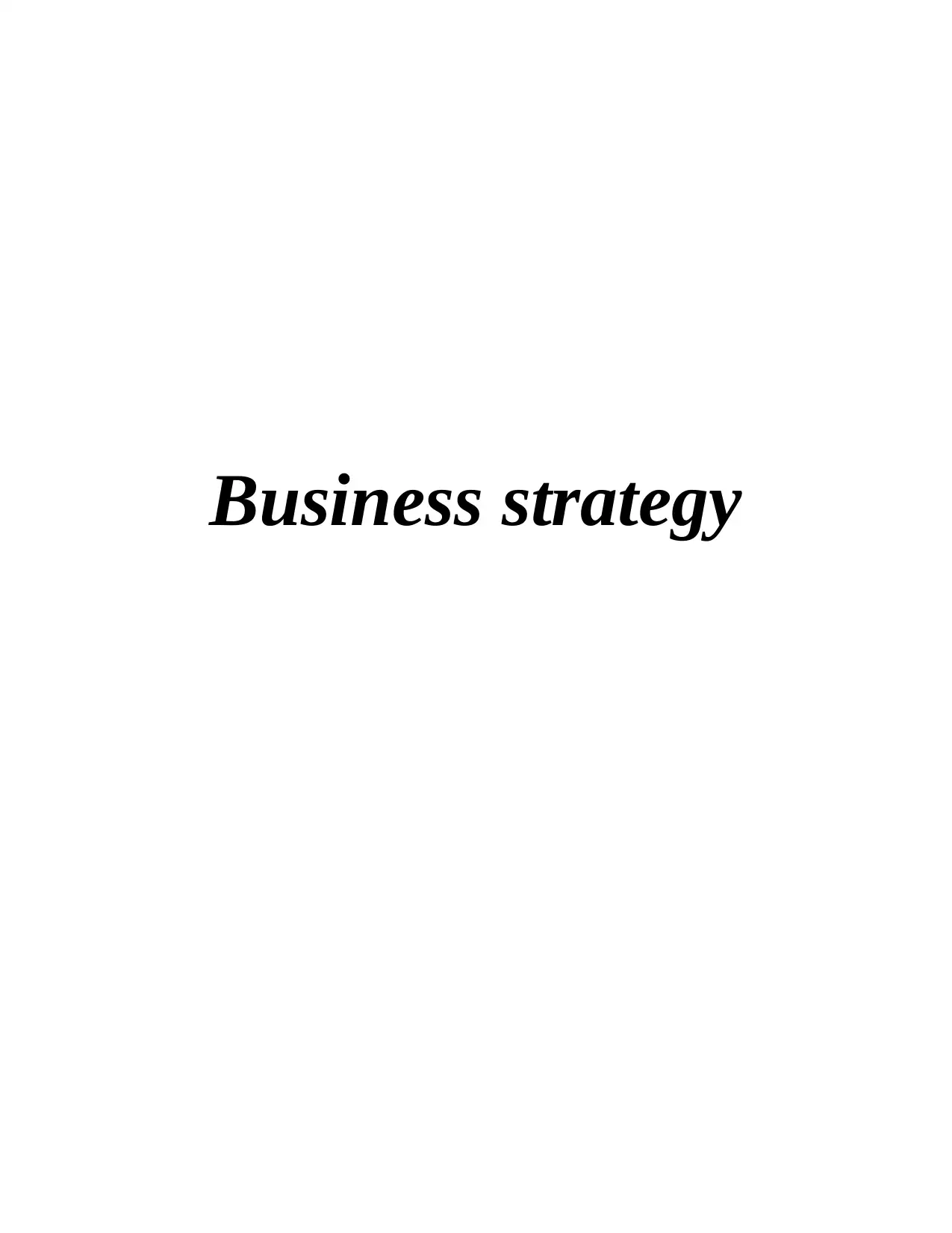
Business strategy
Paraphrase This Document
Need a fresh take? Get an instant paraphrase of this document with our AI Paraphraser
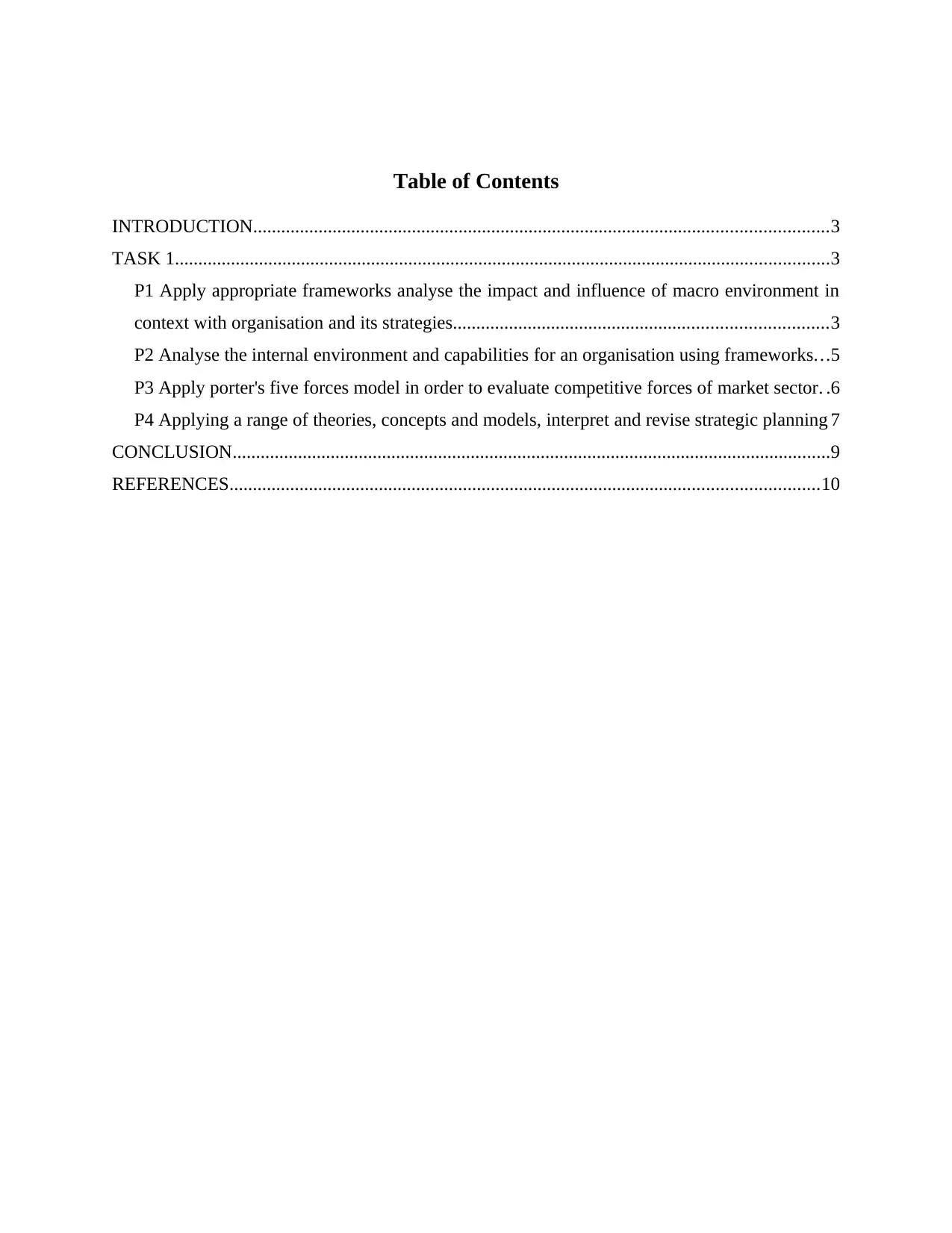
Table of Contents
INTRODUCTION...........................................................................................................................3
TASK 1............................................................................................................................................3
P1 Apply appropriate frameworks analyse the impact and influence of macro environment in
context with organisation and its strategies................................................................................3
P2 Analyse the internal environment and capabilities for an organisation using frameworks...5
P3 Apply porter's five forces model in order to evaluate competitive forces of market sector. .6
P4 Applying a range of theories, concepts and models, interpret and revise strategic planning 7
CONCLUSION................................................................................................................................9
REFERENCES..............................................................................................................................10
INTRODUCTION...........................................................................................................................3
TASK 1............................................................................................................................................3
P1 Apply appropriate frameworks analyse the impact and influence of macro environment in
context with organisation and its strategies................................................................................3
P2 Analyse the internal environment and capabilities for an organisation using frameworks...5
P3 Apply porter's five forces model in order to evaluate competitive forces of market sector. .6
P4 Applying a range of theories, concepts and models, interpret and revise strategic planning 7
CONCLUSION................................................................................................................................9
REFERENCES..............................................................................................................................10
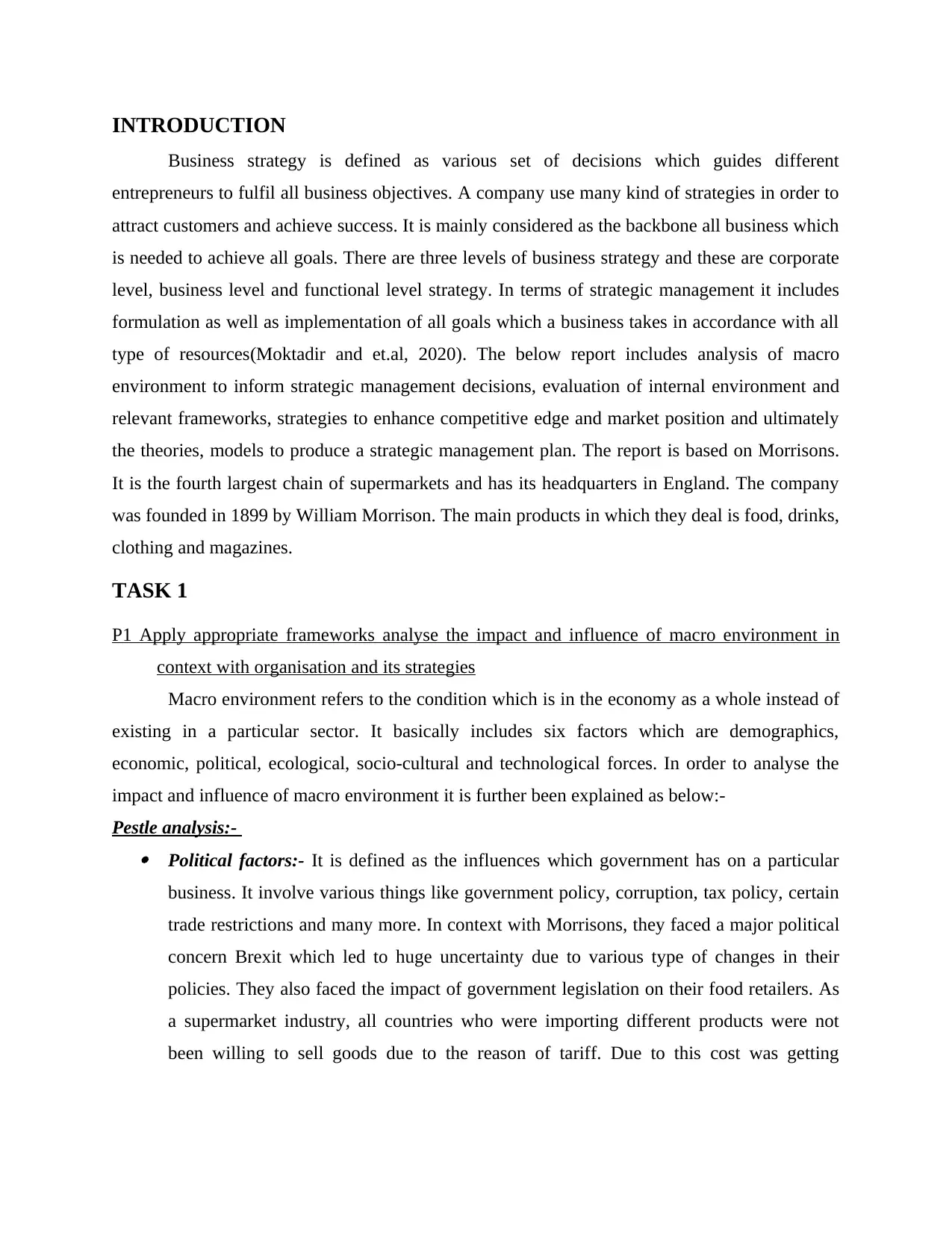
INTRODUCTION
Business strategy is defined as various set of decisions which guides different
entrepreneurs to fulfil all business objectives. A company use many kind of strategies in order to
attract customers and achieve success. It is mainly considered as the backbone all business which
is needed to achieve all goals. There are three levels of business strategy and these are corporate
level, business level and functional level strategy. In terms of strategic management it includes
formulation as well as implementation of all goals which a business takes in accordance with all
type of resources(Moktadir and et.al, 2020). The below report includes analysis of macro
environment to inform strategic management decisions, evaluation of internal environment and
relevant frameworks, strategies to enhance competitive edge and market position and ultimately
the theories, models to produce a strategic management plan. The report is based on Morrisons.
It is the fourth largest chain of supermarkets and has its headquarters in England. The company
was founded in 1899 by William Morrison. The main products in which they deal is food, drinks,
clothing and magazines.
TASK 1
P1 Apply appropriate frameworks analyse the impact and influence of macro environment in
context with organisation and its strategies
Macro environment refers to the condition which is in the economy as a whole instead of
existing in a particular sector. It basically includes six factors which are demographics,
economic, political, ecological, socio-cultural and technological forces. In order to analyse the
impact and influence of macro environment it is further been explained as below:-
Pestle analysis:- Political factors:- It is defined as the influences which government has on a particular
business. It involve various things like government policy, corruption, tax policy, certain
trade restrictions and many more. In context with Morrisons, they faced a major political
concern Brexit which led to huge uncertainty due to various type of changes in their
policies. They also faced the impact of government legislation on their food retailers. As
a supermarket industry, all countries who were importing different products were not
been willing to sell goods due to the reason of tariff. Due to this cost was getting
Business strategy is defined as various set of decisions which guides different
entrepreneurs to fulfil all business objectives. A company use many kind of strategies in order to
attract customers and achieve success. It is mainly considered as the backbone all business which
is needed to achieve all goals. There are three levels of business strategy and these are corporate
level, business level and functional level strategy. In terms of strategic management it includes
formulation as well as implementation of all goals which a business takes in accordance with all
type of resources(Moktadir and et.al, 2020). The below report includes analysis of macro
environment to inform strategic management decisions, evaluation of internal environment and
relevant frameworks, strategies to enhance competitive edge and market position and ultimately
the theories, models to produce a strategic management plan. The report is based on Morrisons.
It is the fourth largest chain of supermarkets and has its headquarters in England. The company
was founded in 1899 by William Morrison. The main products in which they deal is food, drinks,
clothing and magazines.
TASK 1
P1 Apply appropriate frameworks analyse the impact and influence of macro environment in
context with organisation and its strategies
Macro environment refers to the condition which is in the economy as a whole instead of
existing in a particular sector. It basically includes six factors which are demographics,
economic, political, ecological, socio-cultural and technological forces. In order to analyse the
impact and influence of macro environment it is further been explained as below:-
Pestle analysis:- Political factors:- It is defined as the influences which government has on a particular
business. It involve various things like government policy, corruption, tax policy, certain
trade restrictions and many more. In context with Morrisons, they faced a major political
concern Brexit which led to huge uncertainty due to various type of changes in their
policies. They also faced the impact of government legislation on their food retailers. As
a supermarket industry, all countries who were importing different products were not
been willing to sell goods due to the reason of tariff. Due to this cost was getting
⊘ This is a preview!⊘
Do you want full access?
Subscribe today to unlock all pages.

Trusted by 1+ million students worldwide
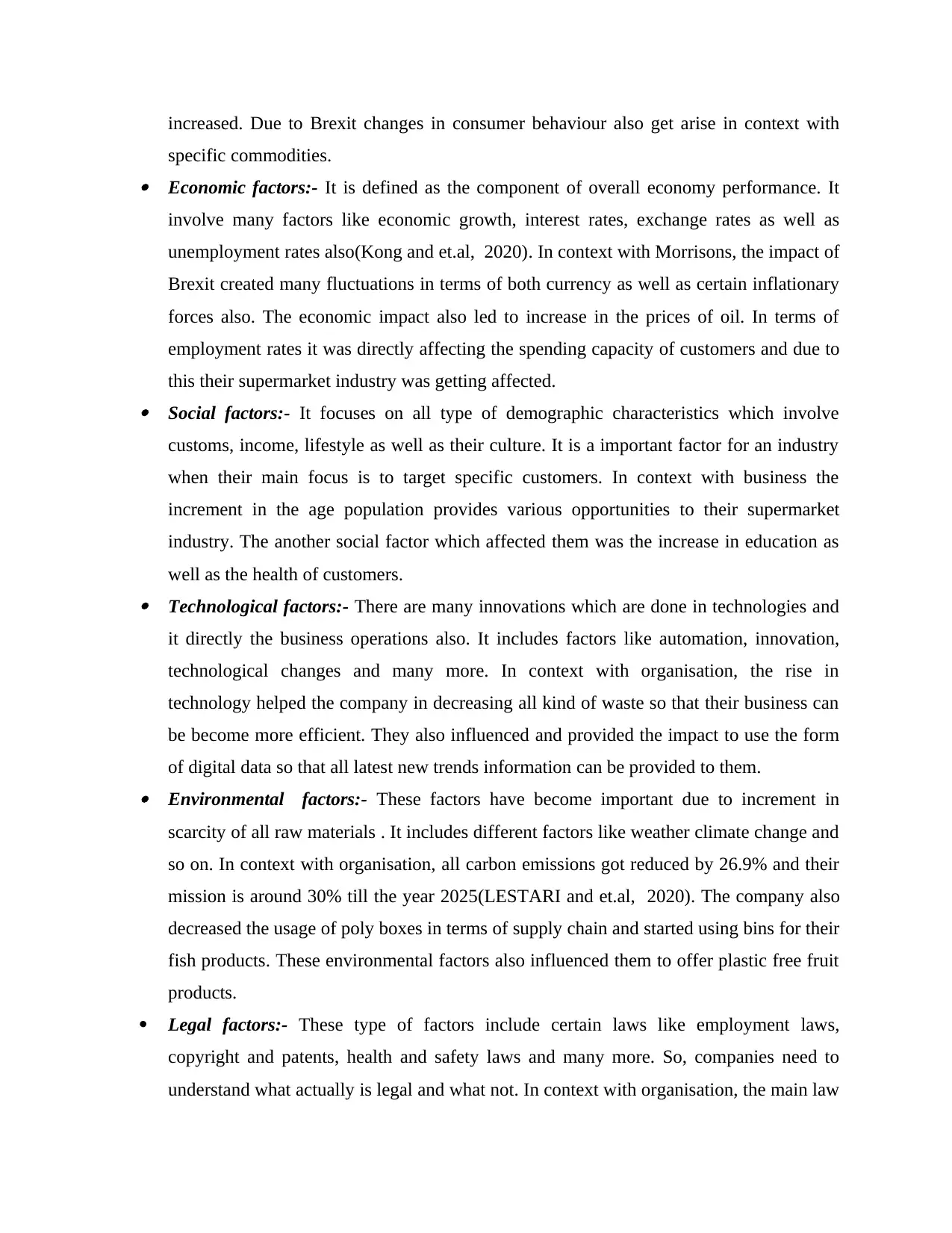
increased. Due to Brexit changes in consumer behaviour also get arise in context with
specific commodities. Economic factors:- It is defined as the component of overall economy performance. It
involve many factors like economic growth, interest rates, exchange rates as well as
unemployment rates also(Kong and et.al, 2020). In context with Morrisons, the impact of
Brexit created many fluctuations in terms of both currency as well as certain inflationary
forces also. The economic impact also led to increase in the prices of oil. In terms of
employment rates it was directly affecting the spending capacity of customers and due to
this their supermarket industry was getting affected. Social factors:- It focuses on all type of demographic characteristics which involve
customs, income, lifestyle as well as their culture. It is a important factor for an industry
when their main focus is to target specific customers. In context with business the
increment in the age population provides various opportunities to their supermarket
industry. The another social factor which affected them was the increase in education as
well as the health of customers. Technological factors:- There are many innovations which are done in technologies and
it directly the business operations also. It includes factors like automation, innovation,
technological changes and many more. In context with organisation, the rise in
technology helped the company in decreasing all kind of waste so that their business can
be become more efficient. They also influenced and provided the impact to use the form
of digital data so that all latest new trends information can be provided to them. Environmental factors:- These factors have become important due to increment in
scarcity of all raw materials . It includes different factors like weather climate change and
so on. In context with organisation, all carbon emissions got reduced by 26.9% and their
mission is around 30% till the year 2025(LESTARI and et.al, 2020). The company also
decreased the usage of poly boxes in terms of supply chain and started using bins for their
fish products. These environmental factors also influenced them to offer plastic free fruit
products.
Legal factors:- These type of factors include certain laws like employment laws,
copyright and patents, health and safety laws and many more. So, companies need to
understand what actually is legal and what not. In context with organisation, the main law
specific commodities. Economic factors:- It is defined as the component of overall economy performance. It
involve many factors like economic growth, interest rates, exchange rates as well as
unemployment rates also(Kong and et.al, 2020). In context with Morrisons, the impact of
Brexit created many fluctuations in terms of both currency as well as certain inflationary
forces also. The economic impact also led to increase in the prices of oil. In terms of
employment rates it was directly affecting the spending capacity of customers and due to
this their supermarket industry was getting affected. Social factors:- It focuses on all type of demographic characteristics which involve
customs, income, lifestyle as well as their culture. It is a important factor for an industry
when their main focus is to target specific customers. In context with business the
increment in the age population provides various opportunities to their supermarket
industry. The another social factor which affected them was the increase in education as
well as the health of customers. Technological factors:- There are many innovations which are done in technologies and
it directly the business operations also. It includes factors like automation, innovation,
technological changes and many more. In context with organisation, the rise in
technology helped the company in decreasing all kind of waste so that their business can
be become more efficient. They also influenced and provided the impact to use the form
of digital data so that all latest new trends information can be provided to them. Environmental factors:- These factors have become important due to increment in
scarcity of all raw materials . It includes different factors like weather climate change and
so on. In context with organisation, all carbon emissions got reduced by 26.9% and their
mission is around 30% till the year 2025(LESTARI and et.al, 2020). The company also
decreased the usage of poly boxes in terms of supply chain and started using bins for their
fish products. These environmental factors also influenced them to offer plastic free fruit
products.
Legal factors:- These type of factors include certain laws like employment laws,
copyright and patents, health and safety laws and many more. So, companies need to
understand what actually is legal and what not. In context with organisation, the main law
Paraphrase This Document
Need a fresh take? Get an instant paraphrase of this document with our AI Paraphraser
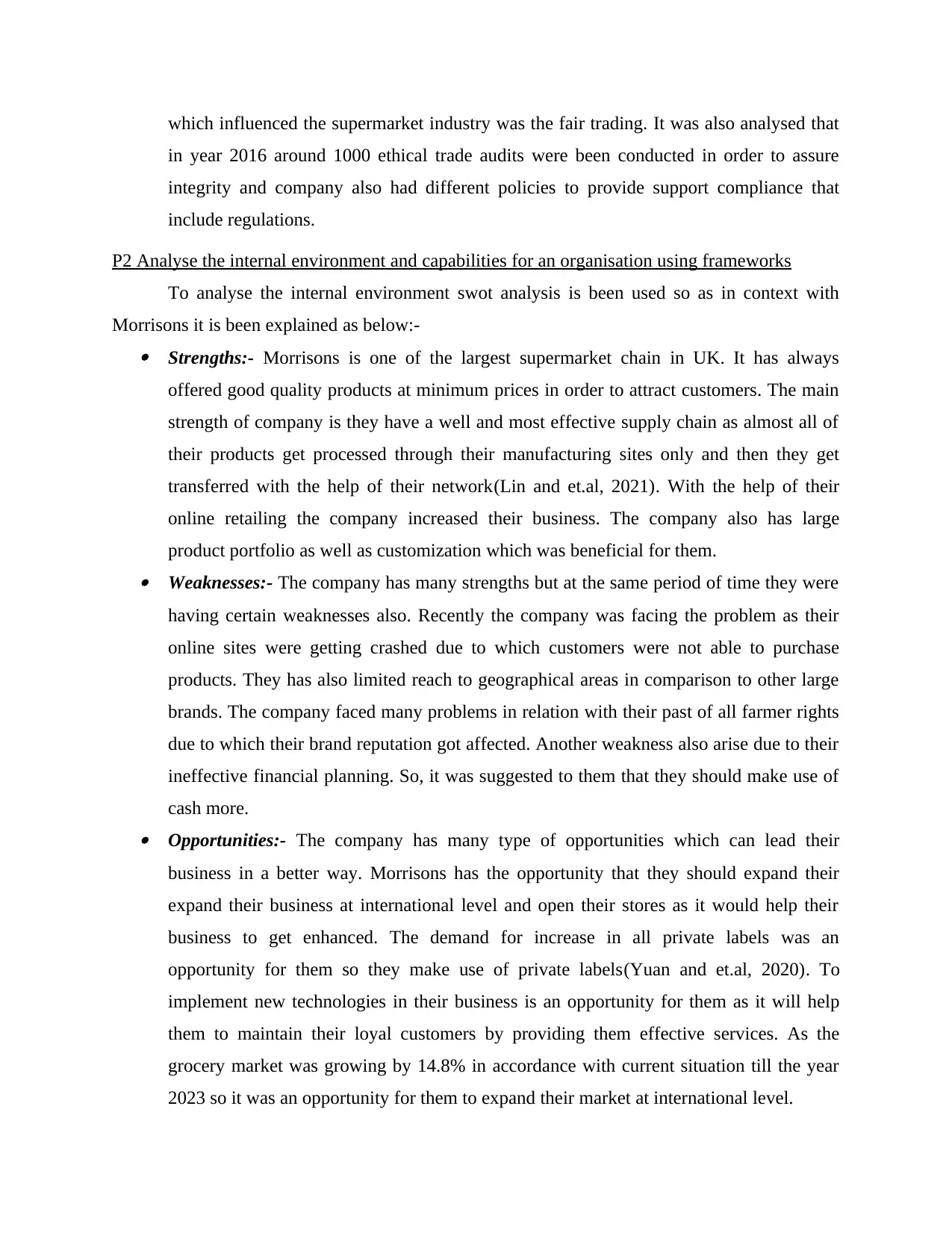
which influenced the supermarket industry was the fair trading. It was also analysed that
in year 2016 around 1000 ethical trade audits were been conducted in order to assure
integrity and company also had different policies to provide support compliance that
include regulations.
P2 Analyse the internal environment and capabilities for an organisation using frameworks
To analyse the internal environment swot analysis is been used so as in context with
Morrisons it is been explained as below:- Strengths:- Morrisons is one of the largest supermarket chain in UK. It has always
offered good quality products at minimum prices in order to attract customers. The main
strength of company is they have a well and most effective supply chain as almost all of
their products get processed through their manufacturing sites only and then they get
transferred with the help of their network(Lin and et.al, 2021). With the help of their
online retailing the company increased their business. The company also has large
product portfolio as well as customization which was beneficial for them. Weaknesses:- The company has many strengths but at the same period of time they were
having certain weaknesses also. Recently the company was facing the problem as their
online sites were getting crashed due to which customers were not able to purchase
products. They has also limited reach to geographical areas in comparison to other large
brands. The company faced many problems in relation with their past of all farmer rights
due to which their brand reputation got affected. Another weakness also arise due to their
ineffective financial planning. So, it was suggested to them that they should make use of
cash more. Opportunities:- The company has many type of opportunities which can lead their
business in a better way. Morrisons has the opportunity that they should expand their
expand their business at international level and open their stores as it would help their
business to get enhanced. The demand for increase in all private labels was an
opportunity for them so they make use of private labels(Yuan and et.al, 2020). To
implement new technologies in their business is an opportunity for them as it will help
them to maintain their loyal customers by providing them effective services. As the
grocery market was growing by 14.8% in accordance with current situation till the year
2023 so it was an opportunity for them to expand their market at international level.
in year 2016 around 1000 ethical trade audits were been conducted in order to assure
integrity and company also had different policies to provide support compliance that
include regulations.
P2 Analyse the internal environment and capabilities for an organisation using frameworks
To analyse the internal environment swot analysis is been used so as in context with
Morrisons it is been explained as below:- Strengths:- Morrisons is one of the largest supermarket chain in UK. It has always
offered good quality products at minimum prices in order to attract customers. The main
strength of company is they have a well and most effective supply chain as almost all of
their products get processed through their manufacturing sites only and then they get
transferred with the help of their network(Lin and et.al, 2021). With the help of their
online retailing the company increased their business. The company also has large
product portfolio as well as customization which was beneficial for them. Weaknesses:- The company has many strengths but at the same period of time they were
having certain weaknesses also. Recently the company was facing the problem as their
online sites were getting crashed due to which customers were not able to purchase
products. They has also limited reach to geographical areas in comparison to other large
brands. The company faced many problems in relation with their past of all farmer rights
due to which their brand reputation got affected. Another weakness also arise due to their
ineffective financial planning. So, it was suggested to them that they should make use of
cash more. Opportunities:- The company has many type of opportunities which can lead their
business in a better way. Morrisons has the opportunity that they should expand their
expand their business at international level and open their stores as it would help their
business to get enhanced. The demand for increase in all private labels was an
opportunity for them so they make use of private labels(Yuan and et.al, 2020). To
implement new technologies in their business is an opportunity for them as it will help
them to maintain their loyal customers by providing them effective services. As the
grocery market was growing by 14.8% in accordance with current situation till the year
2023 so it was an opportunity for them to expand their market at international level.
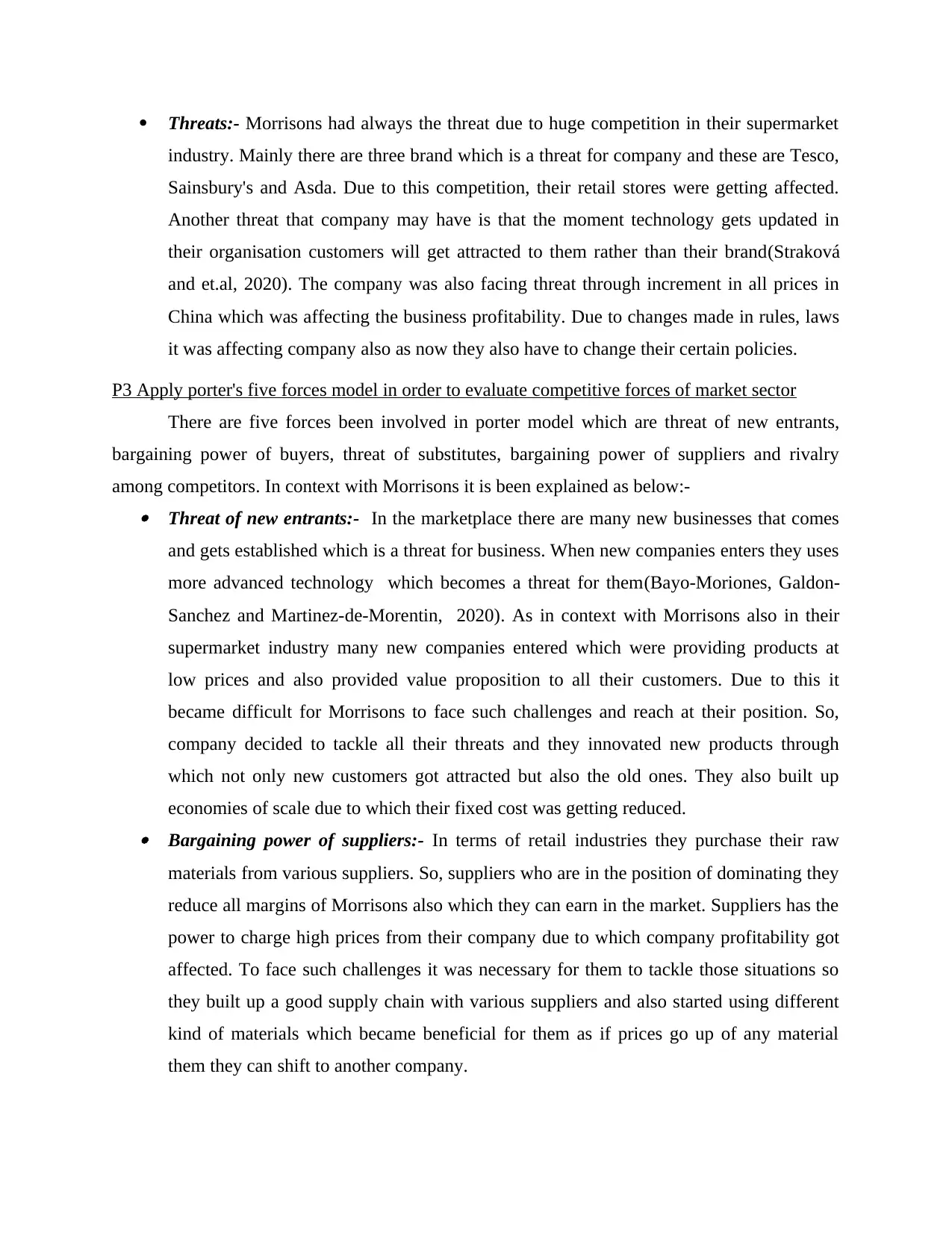
Threats:- Morrisons had always the threat due to huge competition in their supermarket
industry. Mainly there are three brand which is a threat for company and these are Tesco,
Sainsbury's and Asda. Due to this competition, their retail stores were getting affected.
Another threat that company may have is that the moment technology gets updated in
their organisation customers will get attracted to them rather than their brand(Straková
and et.al, 2020). The company was also facing threat through increment in all prices in
China which was affecting the business profitability. Due to changes made in rules, laws
it was affecting company also as now they also have to change their certain policies.
P3 Apply porter's five forces model in order to evaluate competitive forces of market sector
There are five forces been involved in porter model which are threat of new entrants,
bargaining power of buyers, threat of substitutes, bargaining power of suppliers and rivalry
among competitors. In context with Morrisons it is been explained as below:- Threat of new entrants:- In the marketplace there are many new businesses that comes
and gets established which is a threat for business. When new companies enters they uses
more advanced technology which becomes a threat for them(Bayo-Moriones, Galdon-
Sanchez and Martinez-de-Morentin, 2020). As in context with Morrisons also in their
supermarket industry many new companies entered which were providing products at
low prices and also provided value proposition to all their customers. Due to this it
became difficult for Morrisons to face such challenges and reach at their position. So,
company decided to tackle all their threats and they innovated new products through
which not only new customers got attracted but also the old ones. They also built up
economies of scale due to which their fixed cost was getting reduced. Bargaining power of suppliers:- In terms of retail industries they purchase their raw
materials from various suppliers. So, suppliers who are in the position of dominating they
reduce all margins of Morrisons also which they can earn in the market. Suppliers has the
power to charge high prices from their company due to which company profitability got
affected. To face such challenges it was necessary for them to tackle those situations so
they built up a good supply chain with various suppliers and also started using different
kind of materials which became beneficial for them as if prices go up of any material
them they can shift to another company.
industry. Mainly there are three brand which is a threat for company and these are Tesco,
Sainsbury's and Asda. Due to this competition, their retail stores were getting affected.
Another threat that company may have is that the moment technology gets updated in
their organisation customers will get attracted to them rather than their brand(Straková
and et.al, 2020). The company was also facing threat through increment in all prices in
China which was affecting the business profitability. Due to changes made in rules, laws
it was affecting company also as now they also have to change their certain policies.
P3 Apply porter's five forces model in order to evaluate competitive forces of market sector
There are five forces been involved in porter model which are threat of new entrants,
bargaining power of buyers, threat of substitutes, bargaining power of suppliers and rivalry
among competitors. In context with Morrisons it is been explained as below:- Threat of new entrants:- In the marketplace there are many new businesses that comes
and gets established which is a threat for business. When new companies enters they uses
more advanced technology which becomes a threat for them(Bayo-Moriones, Galdon-
Sanchez and Martinez-de-Morentin, 2020). As in context with Morrisons also in their
supermarket industry many new companies entered which were providing products at
low prices and also provided value proposition to all their customers. Due to this it
became difficult for Morrisons to face such challenges and reach at their position. So,
company decided to tackle all their threats and they innovated new products through
which not only new customers got attracted but also the old ones. They also built up
economies of scale due to which their fixed cost was getting reduced. Bargaining power of suppliers:- In terms of retail industries they purchase their raw
materials from various suppliers. So, suppliers who are in the position of dominating they
reduce all margins of Morrisons also which they can earn in the market. Suppliers has the
power to charge high prices from their company due to which company profitability got
affected. To face such challenges it was necessary for them to tackle those situations so
they built up a good supply chain with various suppliers and also started using different
kind of materials which became beneficial for them as if prices go up of any material
them they can shift to another company.
⊘ This is a preview!⊘
Do you want full access?
Subscribe today to unlock all pages.

Trusted by 1+ million students worldwide
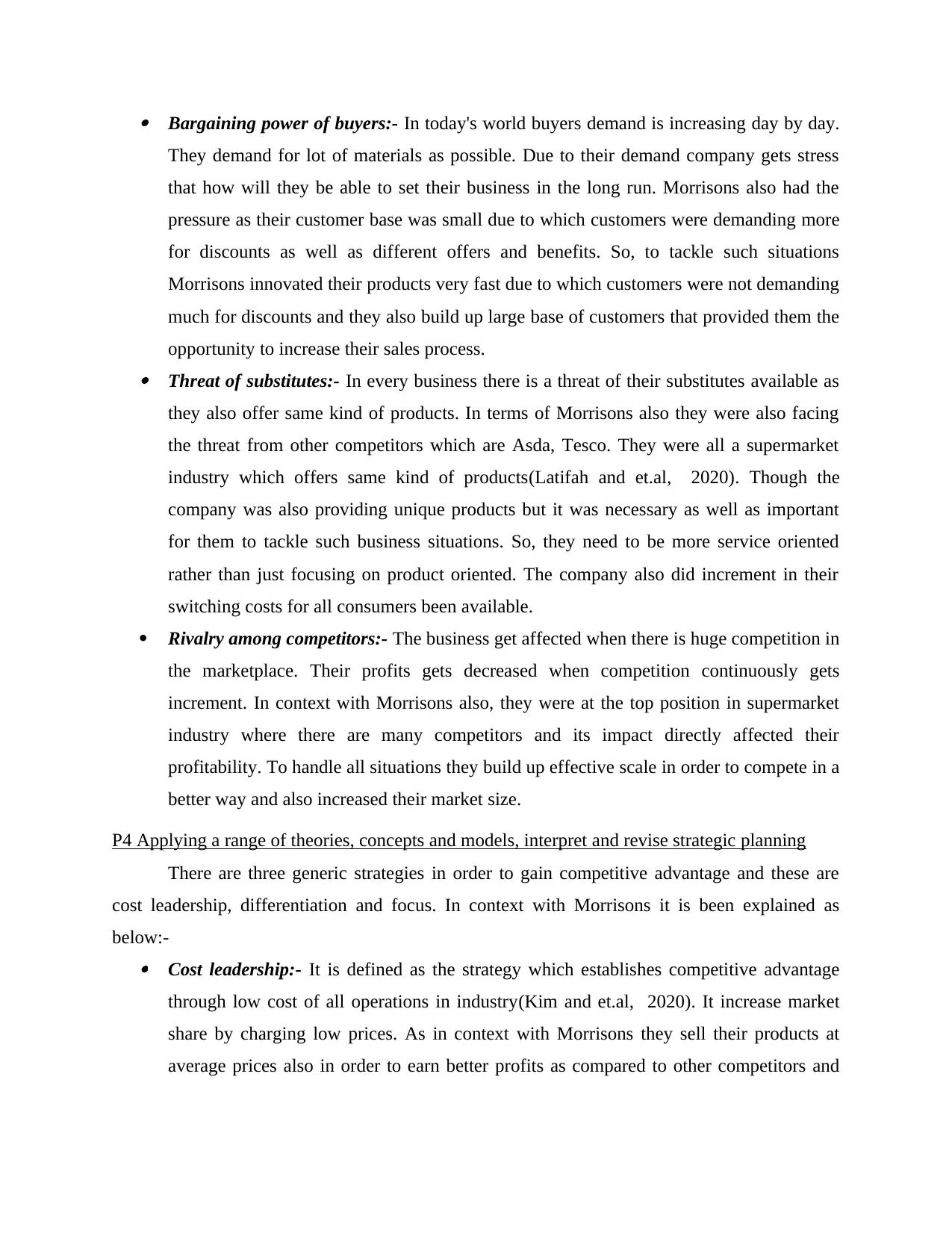
Bargaining power of buyers:- In today's world buyers demand is increasing day by day.
They demand for lot of materials as possible. Due to their demand company gets stress
that how will they be able to set their business in the long run. Morrisons also had the
pressure as their customer base was small due to which customers were demanding more
for discounts as well as different offers and benefits. So, to tackle such situations
Morrisons innovated their products very fast due to which customers were not demanding
much for discounts and they also build up large base of customers that provided them the
opportunity to increase their sales process. Threat of substitutes:- In every business there is a threat of their substitutes available as
they also offer same kind of products. In terms of Morrisons also they were also facing
the threat from other competitors which are Asda, Tesco. They were all a supermarket
industry which offers same kind of products(Latifah and et.al, 2020). Though the
company was also providing unique products but it was necessary as well as important
for them to tackle such business situations. So, they need to be more service oriented
rather than just focusing on product oriented. The company also did increment in their
switching costs for all consumers been available.
Rivalry among competitors:- The business get affected when there is huge competition in
the marketplace. Their profits gets decreased when competition continuously gets
increment. In context with Morrisons also, they were at the top position in supermarket
industry where there are many competitors and its impact directly affected their
profitability. To handle all situations they build up effective scale in order to compete in a
better way and also increased their market size.
P4 Applying a range of theories, concepts and models, interpret and revise strategic planning
There are three generic strategies in order to gain competitive advantage and these are
cost leadership, differentiation and focus. In context with Morrisons it is been explained as
below:- Cost leadership:- It is defined as the strategy which establishes competitive advantage
through low cost of all operations in industry(Kim and et.al, 2020). It increase market
share by charging low prices. As in context with Morrisons they sell their products at
average prices also in order to earn better profits as compared to other competitors and
They demand for lot of materials as possible. Due to their demand company gets stress
that how will they be able to set their business in the long run. Morrisons also had the
pressure as their customer base was small due to which customers were demanding more
for discounts as well as different offers and benefits. So, to tackle such situations
Morrisons innovated their products very fast due to which customers were not demanding
much for discounts and they also build up large base of customers that provided them the
opportunity to increase their sales process. Threat of substitutes:- In every business there is a threat of their substitutes available as
they also offer same kind of products. In terms of Morrisons also they were also facing
the threat from other competitors which are Asda, Tesco. They were all a supermarket
industry which offers same kind of products(Latifah and et.al, 2020). Though the
company was also providing unique products but it was necessary as well as important
for them to tackle such business situations. So, they need to be more service oriented
rather than just focusing on product oriented. The company also did increment in their
switching costs for all consumers been available.
Rivalry among competitors:- The business get affected when there is huge competition in
the marketplace. Their profits gets decreased when competition continuously gets
increment. In context with Morrisons also, they were at the top position in supermarket
industry where there are many competitors and its impact directly affected their
profitability. To handle all situations they build up effective scale in order to compete in a
better way and also increased their market size.
P4 Applying a range of theories, concepts and models, interpret and revise strategic planning
There are three generic strategies in order to gain competitive advantage and these are
cost leadership, differentiation and focus. In context with Morrisons it is been explained as
below:- Cost leadership:- It is defined as the strategy which establishes competitive advantage
through low cost of all operations in industry(Kim and et.al, 2020). It increase market
share by charging low prices. As in context with Morrisons they sell their products at
average prices also in order to earn better profits as compared to other competitors and
Paraphrase This Document
Need a fresh take? Get an instant paraphrase of this document with our AI Paraphraser
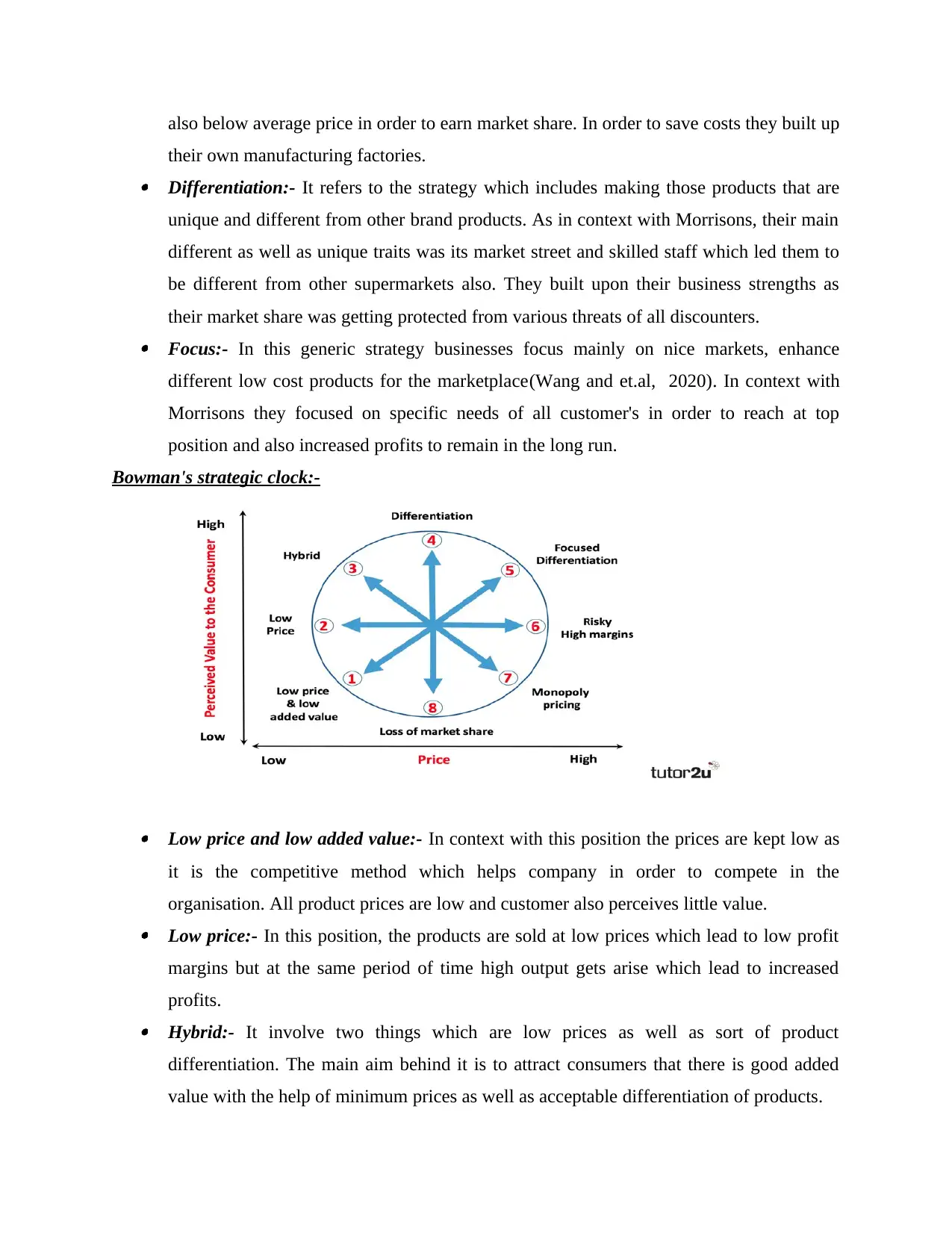
also below average price in order to earn market share. In order to save costs they built up
their own manufacturing factories. Differentiation:- It refers to the strategy which includes making those products that are
unique and different from other brand products. As in context with Morrisons, their main
different as well as unique traits was its market street and skilled staff which led them to
be different from other supermarkets also. They built upon their business strengths as
their market share was getting protected from various threats of all discounters. Focus:- In this generic strategy businesses focus mainly on nice markets, enhance
different low cost products for the marketplace(Wang and et.al, 2020). In context with
Morrisons they focused on specific needs of all customer's in order to reach at top
position and also increased profits to remain in the long run.
Bowman's strategic clock:-
Low price and low added value:- In context with this position the prices are kept low as
it is the competitive method which helps company in order to compete in the
organisation. All product prices are low and customer also perceives little value. Low price:- In this position, the products are sold at low prices which lead to low profit
margins but at the same period of time high output gets arise which lead to increased
profits. Hybrid:- It involve two things which are low prices as well as sort of product
differentiation. The main aim behind it is to attract consumers that there is good added
value with the help of minimum prices as well as acceptable differentiation of products.
their own manufacturing factories. Differentiation:- It refers to the strategy which includes making those products that are
unique and different from other brand products. As in context with Morrisons, their main
different as well as unique traits was its market street and skilled staff which led them to
be different from other supermarkets also. They built upon their business strengths as
their market share was getting protected from various threats of all discounters. Focus:- In this generic strategy businesses focus mainly on nice markets, enhance
different low cost products for the marketplace(Wang and et.al, 2020). In context with
Morrisons they focused on specific needs of all customer's in order to reach at top
position and also increased profits to remain in the long run.
Bowman's strategic clock:-
Low price and low added value:- In context with this position the prices are kept low as
it is the competitive method which helps company in order to compete in the
organisation. All product prices are low and customer also perceives little value. Low price:- In this position, the products are sold at low prices which lead to low profit
margins but at the same period of time high output gets arise which lead to increased
profits. Hybrid:- It involve two things which are low prices as well as sort of product
differentiation. The main aim behind it is to attract consumers that there is good added
value with the help of minimum prices as well as acceptable differentiation of products.
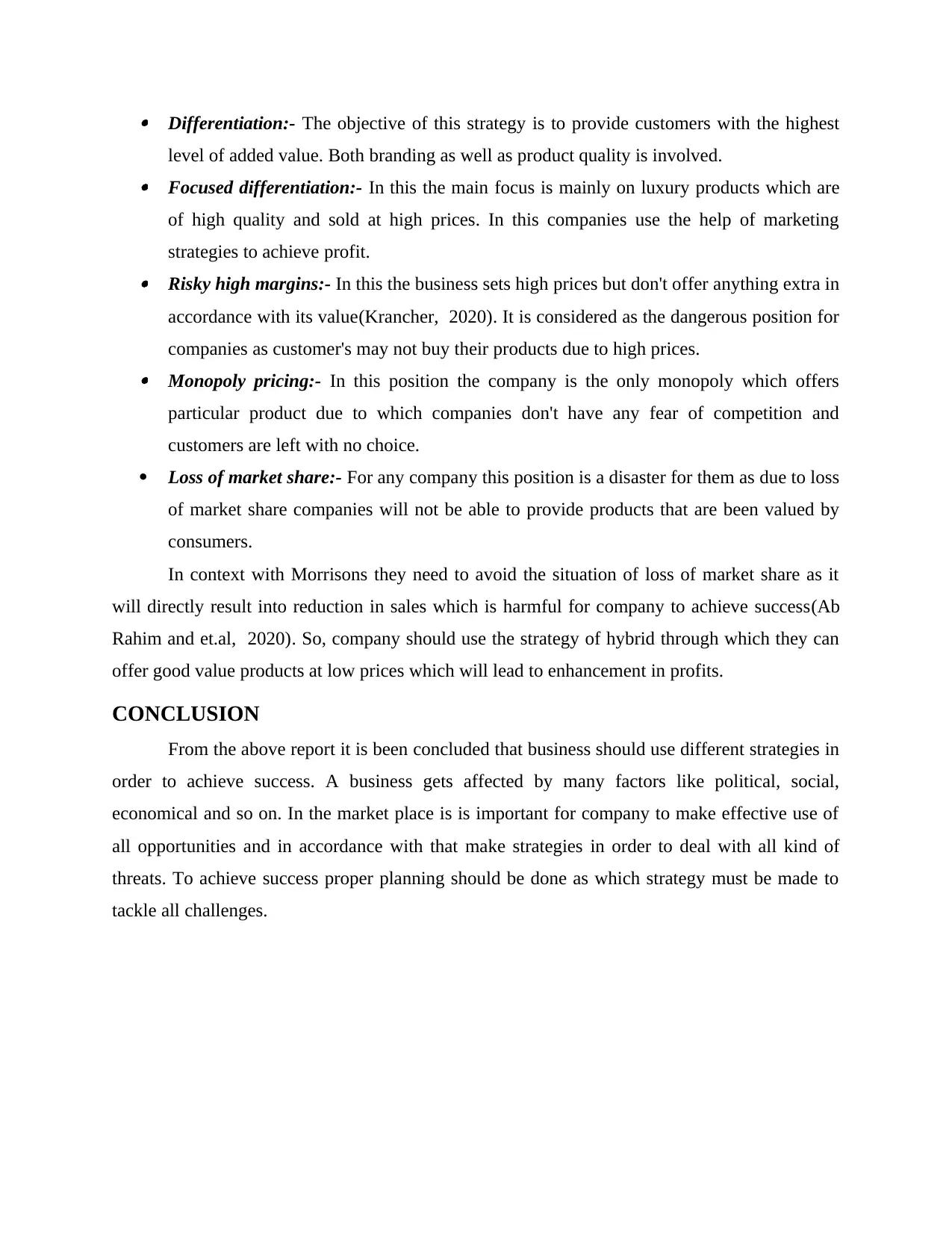
Differentiation:- The objective of this strategy is to provide customers with the highest
level of added value. Both branding as well as product quality is involved. Focused differentiation:- In this the main focus is mainly on luxury products which are
of high quality and sold at high prices. In this companies use the help of marketing
strategies to achieve profit. Risky high margins:- In this the business sets high prices but don't offer anything extra in
accordance with its value(Krancher, 2020). It is considered as the dangerous position for
companies as customer's may not buy their products due to high prices. Monopoly pricing:- In this position the company is the only monopoly which offers
particular product due to which companies don't have any fear of competition and
customers are left with no choice.
Loss of market share:- For any company this position is a disaster for them as due to loss
of market share companies will not be able to provide products that are been valued by
consumers.
In context with Morrisons they need to avoid the situation of loss of market share as it
will directly result into reduction in sales which is harmful for company to achieve success(Ab
Rahim and et.al, 2020). So, company should use the strategy of hybrid through which they can
offer good value products at low prices which will lead to enhancement in profits.
CONCLUSION
From the above report it is been concluded that business should use different strategies in
order to achieve success. A business gets affected by many factors like political, social,
economical and so on. In the market place is is important for company to make effective use of
all opportunities and in accordance with that make strategies in order to deal with all kind of
threats. To achieve success proper planning should be done as which strategy must be made to
tackle all challenges.
level of added value. Both branding as well as product quality is involved. Focused differentiation:- In this the main focus is mainly on luxury products which are
of high quality and sold at high prices. In this companies use the help of marketing
strategies to achieve profit. Risky high margins:- In this the business sets high prices but don't offer anything extra in
accordance with its value(Krancher, 2020). It is considered as the dangerous position for
companies as customer's may not buy their products due to high prices. Monopoly pricing:- In this position the company is the only monopoly which offers
particular product due to which companies don't have any fear of competition and
customers are left with no choice.
Loss of market share:- For any company this position is a disaster for them as due to loss
of market share companies will not be able to provide products that are been valued by
consumers.
In context with Morrisons they need to avoid the situation of loss of market share as it
will directly result into reduction in sales which is harmful for company to achieve success(Ab
Rahim and et.al, 2020). So, company should use the strategy of hybrid through which they can
offer good value products at low prices which will lead to enhancement in profits.
CONCLUSION
From the above report it is been concluded that business should use different strategies in
order to achieve success. A business gets affected by many factors like political, social,
economical and so on. In the market place is is important for company to make effective use of
all opportunities and in accordance with that make strategies in order to deal with all kind of
threats. To achieve success proper planning should be done as which strategy must be made to
tackle all challenges.
⊘ This is a preview!⊘
Do you want full access?
Subscribe today to unlock all pages.

Trusted by 1+ million students worldwide
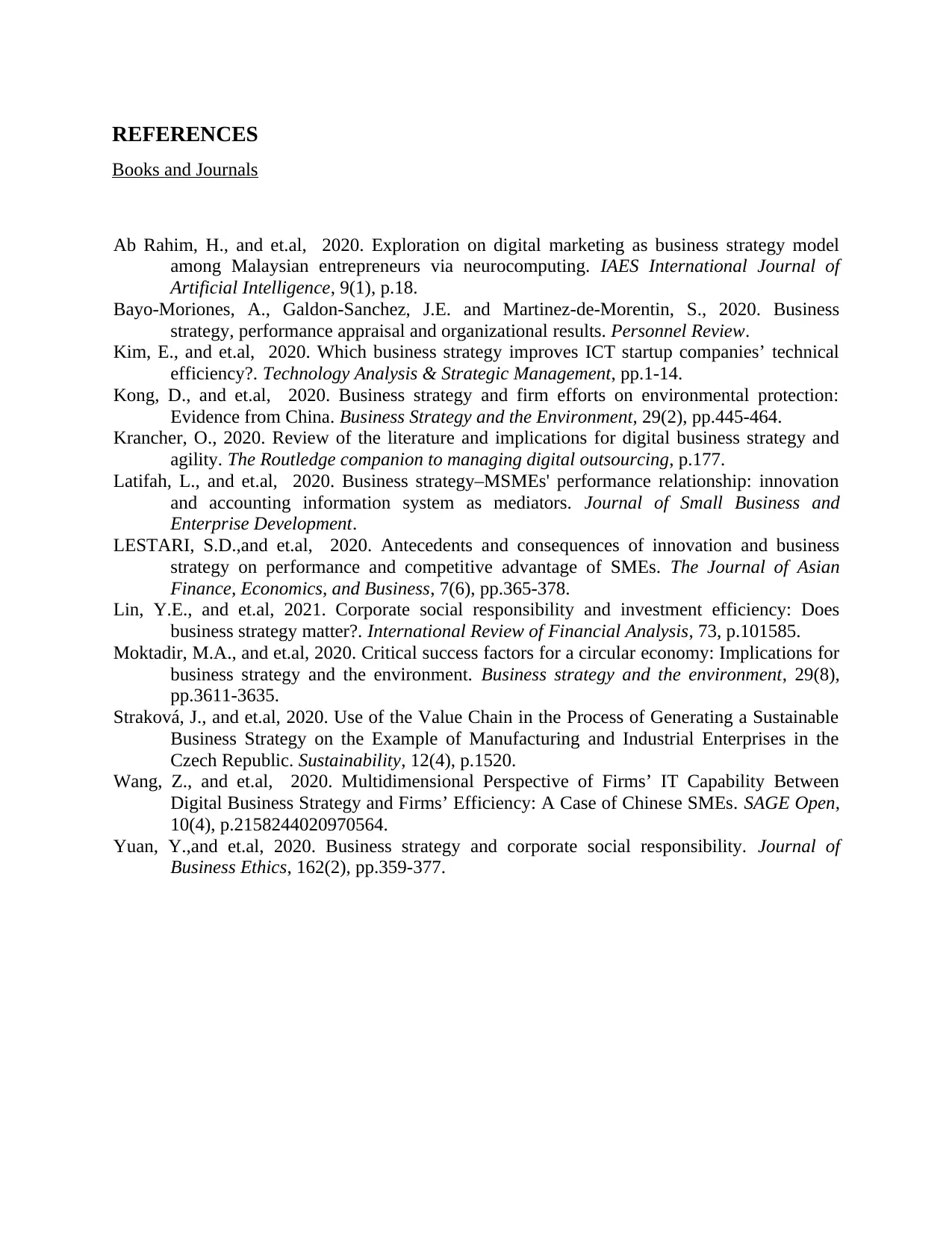
REFERENCES
Books and Journals
Ab Rahim, H., and et.al, 2020. Exploration on digital marketing as business strategy model
among Malaysian entrepreneurs via neurocomputing. IAES International Journal of
Artificial Intelligence, 9(1), p.18.
Bayo-Moriones, A., Galdon-Sanchez, J.E. and Martinez-de-Morentin, S., 2020. Business
strategy, performance appraisal and organizational results. Personnel Review.
Kim, E., and et.al, 2020. Which business strategy improves ICT startup companies’ technical
efficiency?. Technology Analysis & Strategic Management, pp.1-14.
Kong, D., and et.al, 2020. Business strategy and firm efforts on environmental protection:
Evidence from China. Business Strategy and the Environment, 29(2), pp.445-464.
Krancher, O., 2020. Review of the literature and implications for digital business strategy and
agility. The Routledge companion to managing digital outsourcing, p.177.
Latifah, L., and et.al, 2020. Business strategy–MSMEs' performance relationship: innovation
and accounting information system as mediators. Journal of Small Business and
Enterprise Development.
LESTARI, S.D.,and et.al, 2020. Antecedents and consequences of innovation and business
strategy on performance and competitive advantage of SMEs. The Journal of Asian
Finance, Economics, and Business, 7(6), pp.365-378.
Lin, Y.E., and et.al, 2021. Corporate social responsibility and investment efficiency: Does
business strategy matter?. International Review of Financial Analysis, 73, p.101585.
Moktadir, M.A., and et.al, 2020. Critical success factors for a circular economy: Implications for
business strategy and the environment. Business strategy and the environment, 29(8),
pp.3611-3635.
Straková, J., and et.al, 2020. Use of the Value Chain in the Process of Generating a Sustainable
Business Strategy on the Example of Manufacturing and Industrial Enterprises in the
Czech Republic. Sustainability, 12(4), p.1520.
Wang, Z., and et.al, 2020. Multidimensional Perspective of Firms’ IT Capability Between
Digital Business Strategy and Firms’ Efficiency: A Case of Chinese SMEs. SAGE Open,
10(4), p.2158244020970564.
Yuan, Y.,and et.al, 2020. Business strategy and corporate social responsibility. Journal of
Business Ethics, 162(2), pp.359-377.
Books and Journals
Ab Rahim, H., and et.al, 2020. Exploration on digital marketing as business strategy model
among Malaysian entrepreneurs via neurocomputing. IAES International Journal of
Artificial Intelligence, 9(1), p.18.
Bayo-Moriones, A., Galdon-Sanchez, J.E. and Martinez-de-Morentin, S., 2020. Business
strategy, performance appraisal and organizational results. Personnel Review.
Kim, E., and et.al, 2020. Which business strategy improves ICT startup companies’ technical
efficiency?. Technology Analysis & Strategic Management, pp.1-14.
Kong, D., and et.al, 2020. Business strategy and firm efforts on environmental protection:
Evidence from China. Business Strategy and the Environment, 29(2), pp.445-464.
Krancher, O., 2020. Review of the literature and implications for digital business strategy and
agility. The Routledge companion to managing digital outsourcing, p.177.
Latifah, L., and et.al, 2020. Business strategy–MSMEs' performance relationship: innovation
and accounting information system as mediators. Journal of Small Business and
Enterprise Development.
LESTARI, S.D.,and et.al, 2020. Antecedents and consequences of innovation and business
strategy on performance and competitive advantage of SMEs. The Journal of Asian
Finance, Economics, and Business, 7(6), pp.365-378.
Lin, Y.E., and et.al, 2021. Corporate social responsibility and investment efficiency: Does
business strategy matter?. International Review of Financial Analysis, 73, p.101585.
Moktadir, M.A., and et.al, 2020. Critical success factors for a circular economy: Implications for
business strategy and the environment. Business strategy and the environment, 29(8),
pp.3611-3635.
Straková, J., and et.al, 2020. Use of the Value Chain in the Process of Generating a Sustainable
Business Strategy on the Example of Manufacturing and Industrial Enterprises in the
Czech Republic. Sustainability, 12(4), p.1520.
Wang, Z., and et.al, 2020. Multidimensional Perspective of Firms’ IT Capability Between
Digital Business Strategy and Firms’ Efficiency: A Case of Chinese SMEs. SAGE Open,
10(4), p.2158244020970564.
Yuan, Y.,and et.al, 2020. Business strategy and corporate social responsibility. Journal of
Business Ethics, 162(2), pp.359-377.
Paraphrase This Document
Need a fresh take? Get an instant paraphrase of this document with our AI Paraphraser


⊘ This is a preview!⊘
Do you want full access?
Subscribe today to unlock all pages.

Trusted by 1+ million students worldwide
1 out of 14
Related Documents
Your All-in-One AI-Powered Toolkit for Academic Success.
+13062052269
info@desklib.com
Available 24*7 on WhatsApp / Email
![[object Object]](/_next/static/media/star-bottom.7253800d.svg)
Unlock your academic potential
Copyright © 2020–2025 A2Z Services. All Rights Reserved. Developed and managed by ZUCOL.





